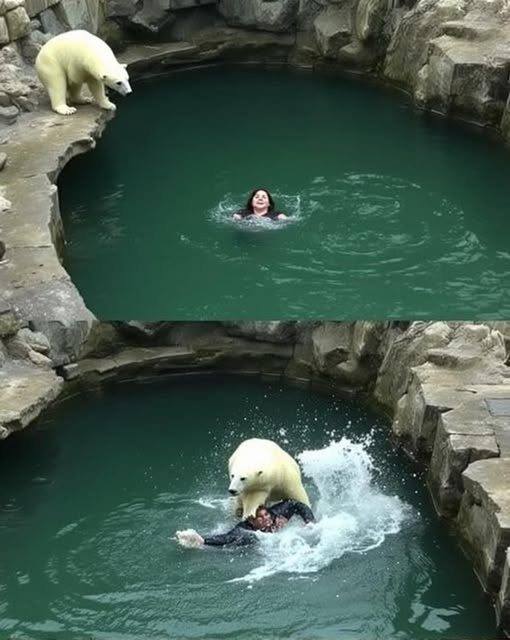Zoos are designed to provide a safe environment for both animals and visitors, but sometimes, human curiosity or reckless behavior leads to dangerous situations. One such shocking incident took place at the Berlin Zoo when a 32-year-old woman climbed into the polar bear enclosure, leading to a terrifying attack that left bystanders horrified and zookeepers scrambling to save her.

This incident raised questions about visitor safety, zoo security measures, and the behavior of wild animals in captivity. It also sparked discussions on what drives people to take such risks and the consequences of ignoring warning signs. Here’s a detailed account of the event, the aftermath, and the lessons to be learned.
The Incident: A Reckless Decision with Dire Consequences
On a seemingly normal day at the Berlin Zoo, visitors were enjoying the sights of the zoo’s exhibits when chaos erupted at the polar bear enclosure. A 32-year-old woman, whose identity was not immediately disclosed, made a shocking and irrational decision—she climbed over the fence and jumped into the polar bear habitat.
Eyewitnesses described the scene as surreal and terrifying. The woman, who was wearing everyday clothing, waded into the water inside the enclosure, coming dangerously close to one of the massive polar bears. It didn’t take long before the bear, reacting naturally to an unfamiliar presence, attacked her.
Despite their often cuddly appearance in pictures, polar bears are among the most powerful predators on Earth. They are built for survival in the harsh Arctic, with powerful muscles, sharp claws, and a bite force that can crush bones. In the wild, they rely on hunting skills to take down seals, making them extremely dangerous to humans in close proximity.
The Attack: A Fight for Survival
As soon as the woman entered the enclosure, one of the polar bears lunged at her, biting her multiple times. The animal’s sharp teeth punctured her arms and legs, and it dragged her through the water. Horrified onlookers screamed, with many pulling out their phones to capture the terrifying event while others desperately called for zoo officials to intervene.
Zookeepers quickly rushed to the scene, knowing that time was critical. They attempted to distract the bear by throwing large pieces of meat into the enclosure, hoping it would lose interest in the woman. Meanwhile, other staff members used poles and hoses to push the bear away from her. After what felt like an eternity to those watching, the bear finally let go, giving zookeepers the chance to pull the woman out of the water.
The rescue was harrowing, as she had sustained severe injuries. She was rushed to the hospital with deep bite wounds, scratches, and bruises. Though she survived, the physical and emotional trauma would likely stay with her for a lifetime.
Why Did She Do It?
One of the biggest questions surrounding the incident was: why? Why would someone willingly enter a polar bear enclosure, knowing the risks?
Investigators and psychologists later suggested several possible reasons. Some speculated that the woman might have been suffering from mental distress or was seeking attention in an extreme way. Others believed she may have had a fascination with animals and genuinely thought she could interact with the bears without being harmed. However, polar bears are not domesticated, and even in captivity, they retain their natural instincts.
Some sources indicated that the woman had ignored multiple warning signs before entering the enclosure. The Berlin Zoo, like all modern zoos, has clear safety measures, including barriers, fences, and warning signs in multiple languages to keep visitors at a safe distance from the animals. Despite these precautions, she found a way to bypass security measures, ultimately putting herself in extreme danger.
Public Reaction: Shock and Debate
News of the incident spread rapidly, with media outlets worldwide covering the story. Many people were horrified and baffled by the woman’s actions, questioning how someone could be so reckless. Others expressed anger, arguing that such behavior not only endangered the woman but also put the polar bears at risk.
Animal welfare advocates were quick to point out that if the situation had escalated further, the bear could have been euthanized to protect human life—something that has tragically happened in similar incidents at other zoos. Many felt that it was unfair for wild animals to suffer consequences for human irresponsibility.
On social media, debates raged about personal responsibility versus institutional safety. Some blamed the zoo for not having stricter security measures, while others argued that no amount of fencing or signs could prevent someone determined to break the rules.
Zoo Safety: Are Current Measures Enough?
The Berlin Zoo, like many other zoos around the world, follows strict safety protocols to prevent accidents and protect both visitors and animals. Enclosures are designed to keep dangerous animals contained while giving them ample space to live in a setting that mimics their natural habitat.
However, incidents like this raise the question: is there more that zoos can do? While it’s nearly impossible to prevent all acts of reckless behavior, some experts have suggested additional measures, such as:
-
Increased Surveillance: More security cameras and on-site personnel to monitor visitor behavior.
-
Stronger Barriers: Higher fences, electric deterrents, or even double-layered enclosures to prevent unauthorized entry.
-
Harsher Penalties: Legal consequences for those who trespass into animal enclosures to discourage such actions in the future.
-
Public Awareness Campaigns: Educating visitors on the dangers of interacting with wild animals and emphasizing why enclosures exist.
Lessons to Learn: Respecting Wildlife
At the core of this incident lies a fundamental lesson: wild animals, even in captivity, are not meant to be approached. They are not pets, and they do not understand human intentions. The polar bear that attacked the woman was not acting out of malice—it was simply reacting to an intruder in its territory.
Respecting wildlife means understanding that these animals are best observed from a safe distance. Zoos provide an opportunity for people to learn about animals without putting themselves at risk. However, when people ignore safety measures, they not only endanger themselves but also disrupt the lives of the animals they claim to admire.
Final Thoughts
The story of the 32-year-old woman who jumped into the polar bear enclosure at the Berlin Zoo serves as a stark reminder of the unpredictability of wild animals and the importance of respecting boundaries. While she was fortunate to survive, her reckless decision could have had far worse consequences.
Zoos will likely continue to review their security measures, but ultimately, visitor safety depends largely on personal responsibility. The next time someone feels tempted to get a closer look at a wild animal, they should remember: some risks are simply not worth taking.

